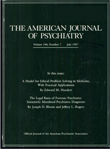Suicide and homicide in the United States: an epidemiologic study of violent death, population changes, and the potential for prediction
Abstract
The authors found significant positive correlations between the suicide and homicide rates for 15-24-year-olds and the proportion of 15-24-year- olds in the U.S. population from 1933 to 1982. Significant negative correlations were found for most adult age groups (35-64 years). Since future numbers of adolescents and adults can be estimated on the basis of current population data for children and preadolescents, the epidemiologic patterns for suicide and homicide may be predictable for certain age groups. However, methodologic problems are inherent in using national mortality and population data, and many years are necessary to evaluate such epidemiologic propositions.
Access content
To read the fulltext, please use one of the options below to sign in or purchase access.- Personal login
- Institutional Login
- Sign in via OpenAthens
- Register for access
-
Please login/register if you wish to pair your device and check access availability.
Not a subscriber?
PsychiatryOnline subscription options offer access to the DSM-5 library, books, journals, CME, and patient resources. This all-in-one virtual library provides psychiatrists and mental health professionals with key resources for diagnosis, treatment, research, and professional development.
Need more help? PsychiatryOnline Customer Service may be reached by emailing [email protected] or by calling 800-368-5777 (in the U.S.) or 703-907-7322 (outside the U.S.).



